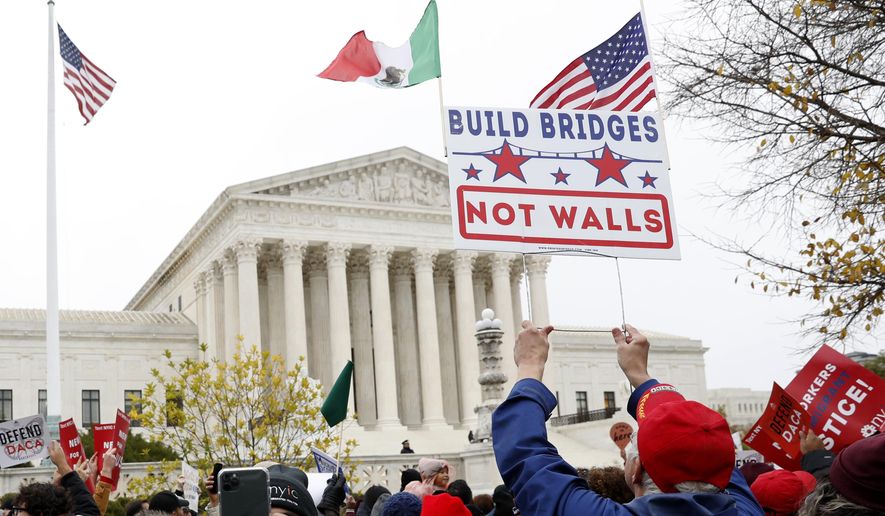DACA can, and probably will, ultimately be ended by the Trump administration.
But the Supreme Court spent Tuesday morning debating whether Homeland Security’s original justification in 2017 for phasing out the Obama-era deportation amnesty was good enough, or whether the justices need to send the matter back for a do-over.
“What’s the point?” wondered Justice Stephen G. Breyer, who seemed sympathetic to the plight of more than 600,000 “Dreamers” currently protected by the 2012 Deferred Action for Childhood Arrivals program, but who also wondered what sense it would make for judges to play “ping pong with the agency.”
Outside the courtroom hundreds of Dreamers rallied, demanding the justices heed their calls to preserve the program that has given them work permits, Social Security numbers, driver’s licenses, taxpayer benefits and a chance to deepen ties to American society.
Inside the courtroom they found a defender in Justice Sonia Sotomayor, who said President Trump had tried to have it both ways, assuring Dreamers he’d take care of them, while pursuing the end of the DACA program that protected them.
“This is not about the law,” she said. “This is about our choice to destroy lives.”
But her passion didn’t bleed over to the other justices who, while acknowledging that livelihoods ride on their ruling, said the case is less about illegal immigration and more about whether Mr. Trump and his team checked all the right boxes in announcing the phaseout in 2017.
Solicitor General Noel Francisco, defending the Trump administration in court Tuesday, said the courts should do very little peering behind the curtain. He pointed to a long line of cases he said show judges must defer to agencies when they lay out the reasons for their decisions.
In this case, he said it was perfectly natural that Homeland Security would want to end the Obama policy that carved people out of immigration-law enforcement.
“Nothing in [immigration law] requires the department, a law enforcement agency, to not enforce the law,” he said.
He warned that if the justices refuse to accept Mr. Trump’s phaseout, they’ll have to grapple with the legality of DACA itself — a program that has long faced serious legal questions, including from Mr. Obama, who repeatedly told immigrants he lacked the power to create such a broad program before reversing himself.
In fact, the program was created by then-Homeland Security Secretary Janet Napolitano, who issued a memo. She did not put the program through notice or comment, nor follow other procedures generally required of major policy changes.
Now Ms. Napolitano, as president of the University of California system, is one of the chief plaintiffs against Mr. Trump, arguing his team didn’t follow the right procedures in winding down her program. She was in the courtroom Tuesday.
Ms. Napolitano’s challenge is part of a messy legal web of cases.
One district court sided with Mr. Trump and approved the phaseout, while three courts ruled against him and said his team failed to provide adequate justification.
Meanwhile, Texas has sued to end Ms. Napolitano’s original 2012 program.
Along the way, courts struck down a similar Obama program known as DAPA, which applied to a broader group of immigrants who are in the U.S. illegally.
DACA applied to immigrants who were under age 31 at the time, who’d come to the U.S. illegally by 2007, had arrived before turning 16 years of age, had pursued a high school education, and who’d kept a relatively clean criminal rap sheet.
The Obama administration said applications would be judged on a case-by-case basis and approval was not automatic — but it was pretty close to being so. In the first full year, 97.7% of cases decided resulted in approval. Even under the Trump administration approval rates were still above 80% until the phaseout was announced.
More than 800,000 people were approved for DACA over its lifetime, and some 660,000 were still under its protections as of September. The others either failed to renew, managed to get a more-permanent status such as by marrying an American, or in some cases had DACA stripped from them for criminal activity.
While high-performing recipients are more common, The Washington Times has detailed some of those criminal entanglements, including more than a dozen who have actually been arrested at the border over the last 18 months on charges of migrant smuggling.
Even the lawyers backing DACA said any administration has the power to wind the program down.
“Yes,” said Theodore B. Olson, one of the lawyers for DACA recipients, in response to a question from Justice Brett M. Kavanaugh.
“So the question then comes down to the explanation,” the justice said.
Yet should the courts rule that Mr. Trump’s phaseout isn’t legal, Mr. Francisco said they’ll have to rule whether Ms. Napolitano’s original memo was legal.
“If you disagree with us on any of our other arguments, you absolutely must address the ultimate legality question because we simply cannot be forced to maintain a policy that this court concludes that is illegal,” he said.
• Stephen Dinan can be reached at sdinan@washingtontimes.com.




Please read our comment policy before commenting.